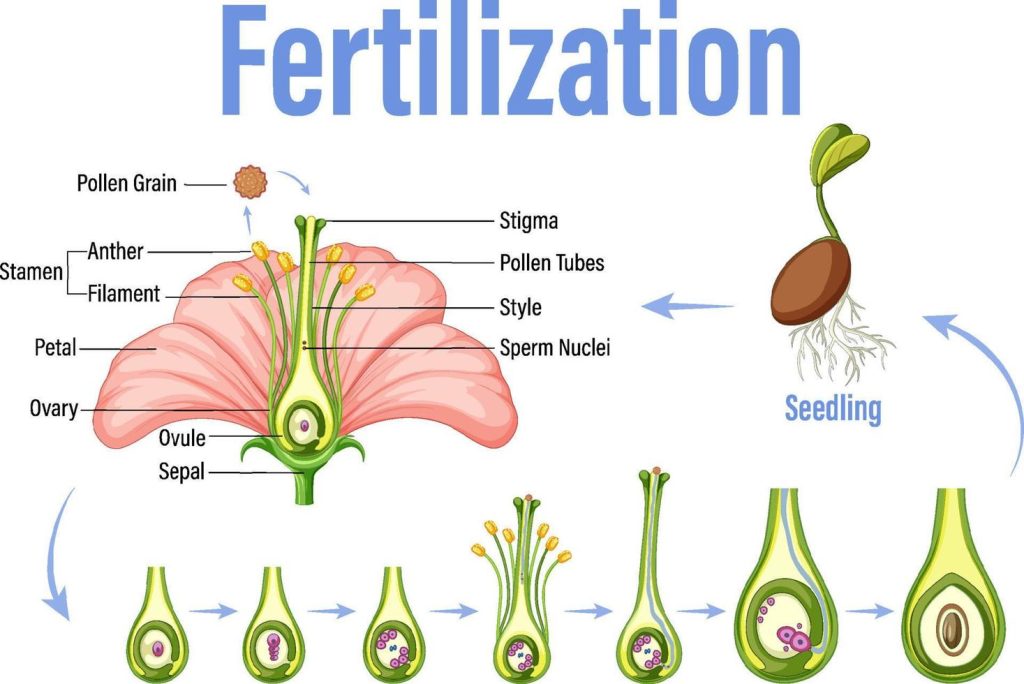Fertilization in Plants- Process and Types
In all organisms, fertilization is the fusion of the hereditary material of two different sex cells, or gametes each of which carries half the number of chromosomes typical of the species.
Fertilization refers to union of a sperm nucleus (paternal origin) with an egg nucleus (maternal origin) to form the primary nucleus of an embryo.
The first significant event in fertilization is the fusion of the membranes of the two gametes, resulting in the formation of a channel that allows the passage of material from one cell to the other. Fertilization in advanced plants is preceded by pollination, during which pollen is transferred to, and establishes contact with, the female gamete or macrospore. Fusion in advanced animals is usually followed by penetration of the egg by a single spermatozoon. The result of fertilization is a cell (zygote) capable of undergoing cell division to form a new individual.
The most important result of fertilization is egg activation, which allows the egg to undergo cell division.
Fertilization Process in Plants
It is the process of fusion of male and female reproductive cells or gametes to produce a fertilized egg (Zygote). The fusion of the male gametes (pollen) with the female gametes (ovum) results in formation of a diploid zygote.
In flowers, the pollen grain germinates after the pollination of the carpel and grows into the style by creating the pathway for the pollen grain to enter the ovary. The pollen tube opens into the ovule through the micropyle and bursts into the embryo sac. Here, the male nucleus unites with the nucleus of an egg inside the ovule forming a diploid zygote, which later swells up and develops into a fruit.
Steps1: Pollination
The transfer of pollen grains from male part of a plant (Anther) to female part of the plant (Stigma) is called pollination. Later fertilization takes place and seed is produced.
Pollination is accomplished by pollinators, who carry the pollens, such as insects, birds, water, wind and rain that can be termed as pollen vectors. These pollens are generally present on the stigma, a part of the pistil of the flower. These pollens can be easily carried to the female gametes for fertilization.
Steps1: Germination
Once the pollen lands on the pistil, it starts germinating and pollen tubes begin growing towards the egg cell for fertilization. The male gamete travels through pollen tubes to the female gamete for the process of fertilization.
Steps1: Fertilization
Pollen tubes grown through the pollen penetrate the ovule which contains the egg or the female gamete. The pollen tube enters the ovule through micropyle and bursts into the embryo sac. The sperm travels to the egg and fuses with it, resulting in fertilization.
Following fertilization, the zygote’s cells start to divide, and it eventually turns into an embryo or growing plant.

Types of Fertilization in Plants
Based on the entry of the pollen tube into the ovule, the process of fertilization can be grouped into:
- Porogamy: This is the most common type of fertilization and takes place in all angiosperms flowering plants). Here, the pollen tube formed through the stigma enters the embryo sac or the ovule through the micropyle.
- Chalazogamy: It takes place in the Casuarina species of plants. In this type of fertilization, the pollen tube enters the ovule through the pollen tube only.
- Mesogamy: This type of fertilization is specific to the Cucurbit plants, such as ridge gourds, bitter gourds, pumpkins and other gourd plants. The pollen tube here enters the ovule through the integuments of the ovule.